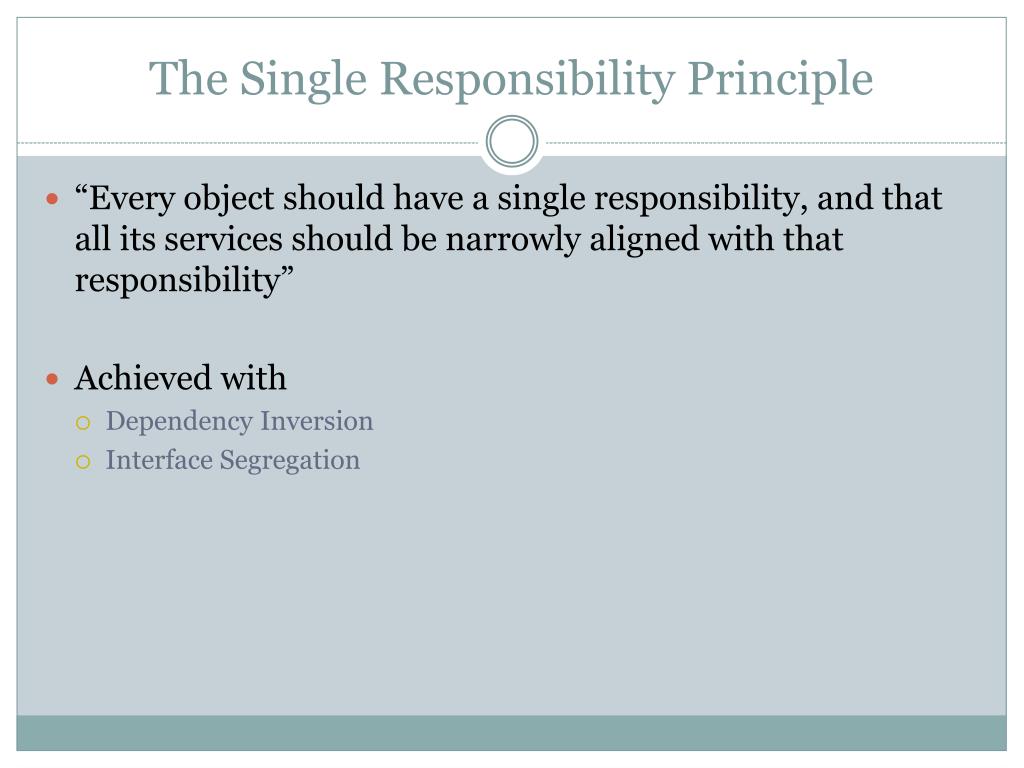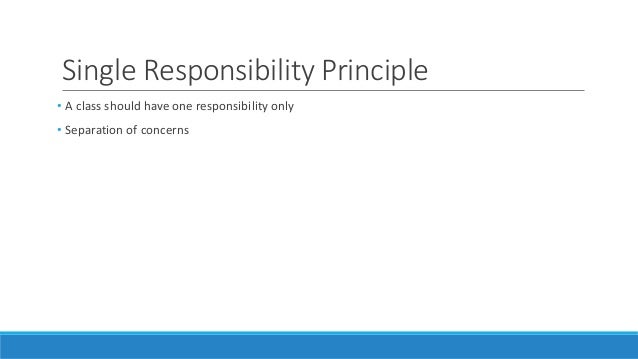

- #SINGLE RESPONSIBILITY PRINCIPLE. SOFTWARE#
- #SINGLE RESPONSIBILITY PRINCIPLE. CODE#
- #SINGLE RESPONSIBILITY PRINCIPLE. FREE#
The Open–closed principle: "Software entities .The Single-responsibility principle: "There should never be more than one reason for a class to change." In other words, every class should have only one responsibility.
#SINGLE RESPONSIBILITY PRINCIPLE. SOFTWARE#
Martin, first introduced in his 2000 paper Design Principles and Design Patterns discussing software rot. The principles are a subset of many principles promoted by American software engineer and instructor Robert C.
#SINGLE RESPONSIBILITY PRINCIPLE. CODE#
It will help not only you but the other developers that need to maintain your code later as well.In software engineering, SOLID is a mnemonic acronym for five design principles intended to make object-oriented designs more understandable, flexible, and maintainable. So refactor towards the SRP later if you are not sure which class does what at that moment. Refactoring is a common practice and nobody writes code perfectly right away. It can be tough to write the code according to SRP right from scratch, but you can write your code iteratively and return to the parts that need attention later. Implementing the Single Responsibility Principle should be always in our mind while writing code. If those classes are not organized and grouped well, it could actually increase the amount of work needed to change a system and to understand it which is opposite of what we wanted to achieve in the first place. But having one big class decomposed into a lot of small classes creates an organizational risk. Implementing SRP leads to writing compact classes with tiny methods as well. We don’t say that it is not possible, just that it will take longer and take more resources as well.

One of the potential downsides is that in projects that are already written, is difficult to implement SRP. The rules are not clear to where we should draw the line, so we can potentially find different „right ways“ to implement the same feature.īut still, the bottom line is that no matter what someone thinks about what reason to change is, we should all strive to write readable and maintainable code thus implementing Single Responsibility Principle in our own way. Everyone interprets this subjectively or rather how he/she feels it should be implemented.

There is no strict rule which states what is that „one reason to change“ in our class. It means that different methods are joined to do one thing and to do it well.įinally, our classes are less dependent on each other (decoupled) which is one of the most important things to achieve while working on a project. When we implement SRP in our code, our methods become highly related (coherent). Furthermore, with such a code, testing becomes easier as well. As we reduce code complexity, our code becomes readable and therefore maintainable.Īs we could see from our example, if our class does its job well, we can reuse its logic in a project.
#SINGLE RESPONSIBILITY PRINCIPLE. FREE#
Because we are trying to accomplish only one task in our class, they have become free of clutter and simple to read. The first one being that it has become less complex. Our code has improved in several ways by implementing SRP. Benefits of Single Responsibility Principle Now every class we have is responsible for one thing and one thing only. Var saver = new "WorkReport.txt", "Schedule.txt", scheduler) Īfter we execute this code, we will have our file saved in a required location on a defined schedule. String.Join(Environment.NewLine, _entries.Select(x => $"Code: ) Public void RemoveEntryAt(int index) => _entries.RemoveAt(index) Public void AddEntry(WorkReportEntry entry) => _entries.Add(entry) The next step is creating a WorkReport class which will handle all the required features for our project: public class WorkReport So we are going to start with a simple model class: public class WorkReportEntry Imagine if we have a task to create a work report feature that, once created, can be saved to a file and perhaps uploaded to the cloud or used for some other purpose.


 0 kommentar(er)
0 kommentar(er)
